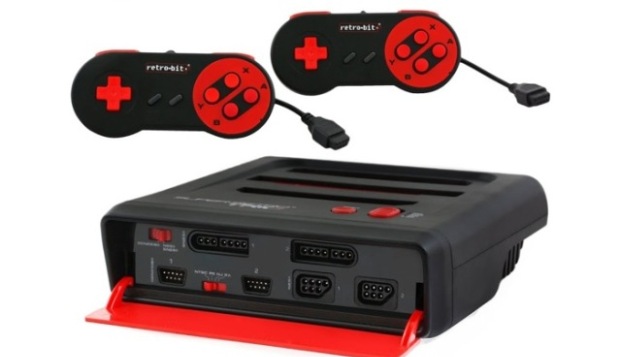Super Retro Trio Review
I can clearly remember several conversations in the early 90’s, where my friends and I would contemplate the possibilities of the “Ultimate Console”, a system that would play games from every console out there. Of course, that lofty dream has been superseded in the past two decades by the ease of emulating older systems using a computer, or more recently with mobile devices, but back then the potential of a multi-console system was mind-blowing.
Likely due to various patents for certain older systems running out in recent times, clone versions of popular systems are become more and more prevalent – and now, the manufacturing quality and availability of these cloned systems are far more satisfactory. The latest of these wonder systems is the Super Retro Trio, which allows you to play Mega Drive, SNES and NES games from any region. There’s even an adapter available that allows you to play Game Boy, GB Color and GB Advance games in the SNES slot as well, although I didn’t have the Super Retro Advance adapter to review.

It’s worth noting right away that this system is made for the North American market, so only a US power adapter is supplied, but this can be easily rectified by using a compatible UK power supply or travel adapter. Another point to make is that this system only seems to run games in 60Hz, so PAL games that are traditionally running at a slower 50Hz speed will be noticeably faster, which may cause issues with some games (especially those that were already optimised for the PAL region, such as Super Mario Kart and Donkey Kong Country).
As well as the Super Retro Trio console itself, the box contains some composite/S-Video cables to connect the system to your television, plus two controllers based on the SNES pad design, but which can be used with NES & Mega Drive games on the SRT as well. These pads are far better than most other third party offerings, but like many third party controllers, are in no way a patch on the originals. Luckily, there are a multitude of ports on the front of the system, allowing you to insert normal NES, SNES & Mega Drive pads for a more authentic experience.
After connecting the composite cables and switching the system on, it is clear that using composite (yellow, red, white) cables on a HDTV is plain ugly. In the UK, we have always had the luxury of connecting our systems via RGB SCART cables for far superior video quality, however the Americans have been limited to composite and S-Video connections. Unfortunately, I don’t have a TV that support S-Video, so the noisy composite connection is my only choice. If you’re going to be using an old-fashioned CRT television with the Super Retro Trio, then the noisy picture is slightly more palatable, possibly even slightly “authentic”, but it’s in no way the best choice for retro gaming on any television.

But video quality aside, system compatibility is fairly decent. Most of the games I threw at the system were fine, although the system fared poorly with my American copy of Castlevania 3 on the NES for some reason, failing to load past the initial introduction. I also tested the Super Retro Trio with a selection of flash cartridges for each system – a Neo Myth MD for the Mega Drive, plus the NES and SNES Powerpak carts. While I could not get the NES Powerpak working, the SNES version and the Neo Myth MD worked fine with the games I threw at it. Clone consoles don’t always play nicely with flash carts, but at least I had some success, and owners of newer flash carts (like the Everdrive) may find better compatibility results than I did with my admittedly older tech.
A welcome feature is a switch on the front to change the region of the Mega Drive, as certain cartridges were coded in a way that you could have the different international versions of the game depending on which region system it was being played on. For example, play Streets of Rage on a Genesis or a PAL Mega Drive and you’ll get the Streets of Rage title we all know and love, while playing the game with the Japanese region selected will bring up the game with its “Bare Knuckle” title screen and changes. It’s just a shame that there isn’t a switch to change between 50/60Hz and between regions for all of the cloned systems.
VERDICT: This is a clone system that, for the most part, makes good on its aim of providing a means of playing games from multiple systems. However, the poor video output options and the occasional compatibility issues make it hard for me to recommend the Retro Trio over original consoles, especially as the superior originals are not difficult to find at a reasonable price, with modifications available for region-free gameplay. Still, if authenticity and video quality are not a major issue for you, this is easily one of the better clone consoles out there – but be warned that Hyperkin’s Retron 5 system is finally coming soon, so it may be worth waiting to see what this alternative will offer.
Review unit provided by Funstock. You can buy the Super Retro Trio here.




